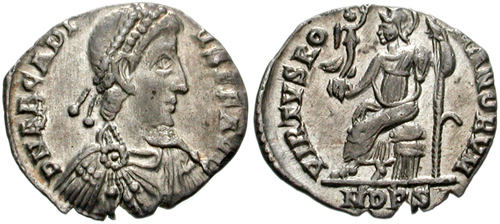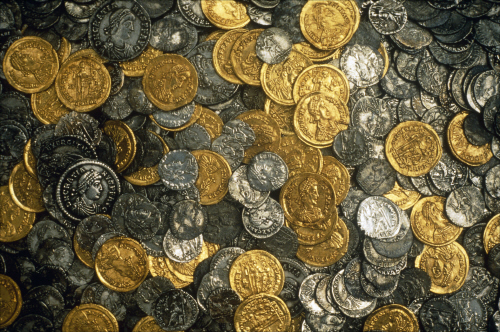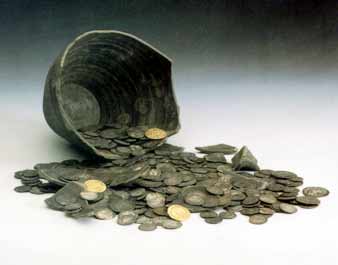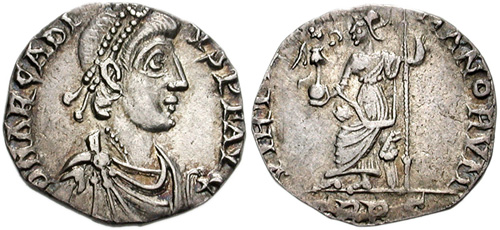|
|
| |
 |
|
The puzzling phenomenon of late Roman coin-clipping or, more specifically, the clipping of silver siliquae, is now receiving an illuminating programme of scholarly scrutiny and examination. The potential findings promise to bring new light to bear on the political and economic turmoil of the late Roman period/immediate post-Roman era in Britain when myth and legend converge so fruitfully, if confusingly, with what passes for the beginnings of ‘Dark Age’ history.
One initial conclusion from the latest research points to an important new interpretation: there was a serious attempt to maintain the Roman monetary system, after the collapse of the province of Britannia.
|
|
| |
Quite how long that ultimately doomed attempt continued is another matter.
But, nonetheless, this is a finding of considerable historical significance. Yet, ironically, discoveries in recent years by metal detector users have done much to underpin the evidence for these new findings - so much so that the co-operation of the detectorists is now being actively sought by the authorities. A little-noticed break-through change in attitude, one that has far-reaching consequences for future studies by historians, coin specialists and archaeologists. .
There are sound academic reasons for this ‘change-of heart‘– if it can be so termed - because the finds made by the often controversial ‘treasure hunters’, trawling the fields of England and Wales on their weekend forays into the countryside, are revealing important new evidence (as recorded with the Government’s Portable Antiquities Scheme through the local Finds Liaison Officers) relating to Roman coins from the period c355 to c410.
And that new evidence is crucial. The province of Britannia(its role as part of theEmpire formally ended in c410)occupies a special place in this context and it does so for one important reason: it has yielded far more late Roman silver coin hoards than any other in the Empire. There is another key factor here that has a wider bearing on post-Roman studies. At some point in the late Roman period, Romano-Britons began
clipping the edges of the silver siliquae – a pattern of monetary self-assertion that has been described as an enigmatic yet very British phenomenon. |
|
| |
|
It is now clear to the ancient coin specialists that the clippings were almost certainly used to make copies and, importantly, in a manner whereby the ‘duplicates’ shared the same fine metal quality of the originals issued by the official imperial mints. It could be that this was not as haphazard or un-co-ordinated - so-called long-termed ‘forger’ activity - that might have been first imagined, suggesting that the local population – across a wide area of the province - were trying to maintain a silver currency at a time when there was a declining stock of the metal. That it itself is an important conclusion, one based on closely monitored recent finds and research.
No firm consensus has yet emerged among scholars on the date when the practice of clipping started. As discussed in Late Coin Hoards and WansdykeKeith Nurse Imperial Coins & Artifacts Newsletter, April/May 2008, Vol 1, Issue 1), it has been suggested that such clipping might have occurred at one or more points – triggered, according to one authority, after AD 402 when the striking of siliquae ceased at the Milan mint. A further finely-tuned interpretation by another expert has suggested that the practice had not started by AD 404, but possibly began in the reign of Constantine 111 (AD 407-11). |
 |
The leading scholar on the subject, the British Museum’s Sam Moorhead
(‘Coin Use after the Fall of the Roman Province’ Treasure Hunting magazine UK, August, 2008) argues that, if the latter post-407-11 dating is indeed the case, then the discovery of clipped siliquae across Britain is even more significant, given that the these rare finds have been uncovered at widely dispersed UK sites - in Berkshire, Sussex, Surrey, Yorkshire, Wiltshire and South London. All these coins had been issued by the late Imperial mints at Trier, Arles and Milan.
It is now clear to the ancient coin specialists that the clippings were almost certainly used to make copies and, importantly, in a manner whereby the ‘duplicates’ shared the same fine metal quality of the originals issued by the official imperial mints. It could be that this was not as haphazard or un-co-ordinated - so-called long-termed ‘forger’ activity - that might have been first imagined, suggesting that the local population – across a wide area of the province - were trying to maintain a silver currency at a time when there was a declining stock of the metal. That it itself is an important conclusion, one based on closely monitored recent finds and research.
No firm consensus has yet emerged among scholars on the date when the practice of clipping started. As discussed in Late Coin Hoards and WansdykeKeith Nurse Imperial Coins & Artifacts Newsletter, April/May 2008, Vol 1, Issue 1), it has been suggested that such clipping might have occurred at one or more points – triggered, according to one authority, after AD 402 when the striking of siliquae ceased at the Milan mint. A further finely-tuned interpretation by another expert has suggested that the practice had not started by AD 404, but possibly began in the reign of Constantine 111 (AD 407-11).
The leading scholar on the subject, the British Museum’s Sam Moorhead
(‘Coin Use after the Fall of the Roman Province’ Treasure Hunting magazine UK, August, 2008) argues that, if the latter post-407-11 dating is indeed the case, then the discovery of clipped siliquae across Britain is even more significant, given that the these rare finds have been uncovered at widely dispersed UK sites - in Berkshire, Sussex, Surrey, Yorkshire, Wiltshire and South London. All these coins had been issued by the late Imperial mints at Trier, Arles and Milan.
Moorhead adds: it(the practice of clipping) might well reflect an attempt to maintain a precious metal currency in everyday circulation after the collapse of the Roman administration. Not only were gold and silver coins being hoarded (as in the Hoxne hoard – a cache of 15,234 late Roman gold and silver coins uncovered in Suffolk in 1992), they were also being used in everyday transactions.’
As the National Finds Adviser (Department of Portable Antiquities at the British Museum), Sam Moorhead occupies an authoritative position with which to reflect on .these issues and his testimony is both up-to-date and highly relevant. |
| Roman coin clipping. 3 |
He writes: ‘Until the late 1990s, I only knew of very few such clipped siliquae from sites in Britain. I always assumed that clipping occurred after gold and silver coins had effectively become bullion, travelling only in large hoard. How wrong I was. Detectorists have recorded over 100 clipped siliquae from sites across Britain, and the number is increasing now that I am highlighting the importance of these coins.’
One of the most important finds in this context was the Bishop Cannings hoard – found in the 1990s near Devizes, Wiltshire, and, significantly located (in my view) close to the enigmatic linear boundary earthwork in Wiltshire, Wansdyke (see Late Coin Hoards and Wansdyke, 2002for coin hoard and earthwork dating suggestions,
reproduced in the Imperial Coins & Artifacts, April/May Newsletter)
The Bishops Cannings hoard contained 1,561 siliquae. Of these, 880 were clipped and 70 were considered to be copies. But there were also an astonishing 5,837 late Roman bronze coins in the same find, mostly dating between 364 and 402. The presence of clipped siliquae suggests, then, a date of deposition after the end of Britain, possibly c 410-20. |
 |
Sam Moorhead concludes: ‘The presence of the bronze coins suggests that they, in addition to clipped siliquae, were also still in circulation. It therefore seems that the evidence from hoards such as the Hoxne (Suffolk) and Bishops Cannings – and the finding of clipped siliquae on sites – that there was a functioning gold, silver and bronze currency continuing for a significant time after AD 410.’
This in turn suggests, in his view, that the (post) Roman Britons made a serious attempt to maintain the Roman monetary system after the collapse of the province of Britannia, though for how long after they managed to sustain this extraordinary attempt at monetary self-sufficiency - if that is indeed what it was - will long continue to be the focus of a lively scholarly debate.
The commonly held view offers a plausible explanation for the background circumstances of civil unrest and barbarian incursions. According to the early sixth century Greek historian (he was also a court official) the Emperor in the West, Honorius (393-423) told the beleaguered city authorities to undertake their own defence. This instruction, by all accounts, was in response to an appeal for assistance by the British provincials – an initiative without parallel in the late Empire. |
|
| Roman coin clipping. 4 |
 |
From the emerging coin evidence, the Romano-British authorities did much more than seek measures for their protection; just as importantly, it would appear that the remaining local administrators took charge of their own monetary affairs. Even if this practice was not initiated by the authorities, the wide dispersal of finds suggests that, in any event, they were powerless to stop it. |
| |
| |
|
|
|
|
|
| Copyright 2008-2009 Imperial Coins & Artifacts, Inc. |
|
|